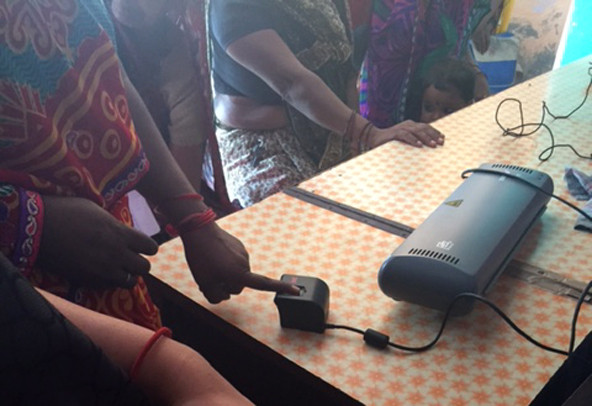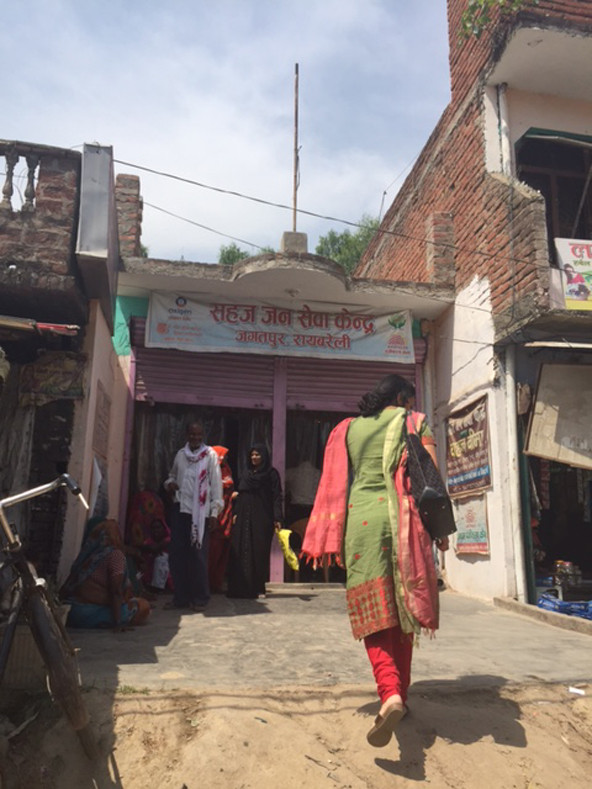 A woman shares her Aadhaar card (her unique biometric identifier), places her finger on a small black box, and within minutes opens a bank account.
A woman shares her Aadhaar card (her unique biometric identifier), places her finger on a small black box, and within minutes opens a bank account.
Among the bustling streets of Gurgaon, outside New Delhi, a young woman enters an Oxigen branch located within a local government center. She shares her Aadhaar card (her unique biometric identifier), places her finger on a small black box, and within minutes she’s opened a bank account. She deposits her weekly cash earnings from her hair salon into her account and puts 700 rupees (roughly $10) into savings. She then transfers $50 to her cousin in Agra with only 1 percent in fees, compared to the typical 5 percent. This is the future of banking in India and potentially the world. And in the not-so-distant future, banking may be completely paperless, presence-less, and real-time, with a full suite of products and services designed to help poor consumers manage their daily finances, better navigate unexpected emergencies, and meet their long-term goals.
In India, a host of players, including telecommunications firms, small finance banks, payment banks, and financial technology companies, are harnessing technology to reinvent traditional business models and offer faster, cheaper, and more convenient financial products and services. Due to a rapid growth in mobile access, credit bureaus, and significant regulatory reforms, India is experiencing a financial inclusion revolution.
 An Oxigen branch located within a local government center outside New Delhi.
An Oxigen branch located within a local government center outside New Delhi.
As part of JPMorgan Chase’s commitment to improving financial health, our mission is to use our global reach to identify some of the best emerging strategies in financial inclusion, such as those in India, share them with our partners across the world, and expand effective programs to reach as many people as possible.
While context matters, we can do more to understand how best to adapt these emerging innovations to other markets. India’s transformation can inform our global efforts to promote financial inclusion, including in the United States, where more than one in four Americans manages their financial lives outside of the banking system and more than half struggle with financial insecurity. India has done significant work to promote an inclusive financial ecosystem, but we still see significant challenges and opportunities for improvement that correspond with similar ones in the United States. Here is a look at three trends in India that can help inform efforts in the United States and elsewhere, and challenges that we must address to make them possible.
Are you enjoying this article? Read more like this, plus SSIR's full archive of content, when you subscribe.
1. Increased mobile usage can drive inclusion. The growth of digital financial services has created new opportunities to reach previously excluded populations. Technology is fueling new identification, authentication, and branch models that will transform the delivery of financial services.
Challenge: While technology is promising to reach the most vulnerable, we know that technology alone will not solve financial insecurity. There are significant gaps in adoption and usage of digital financial products, particularly among specific populations, such as women in India and communities of color in the United States. There are many reasons for this in India: lack of familiarity with technology or illiteracy, privacy concerns with shared devices, and lack of trust in the new technology. Additionally, access does not equal inclusion: Of the 240 million accounts opened under India’s financial inclusion strategy, 24 percent have no funds in the account. Clearly while there is a significant increase in access to accounts, consumers are not using them. This lack of usage underlines the importance of creating products and engagement strategies that are better designed to meet the needs of consumers to ensure that consumers adopt the new products and use them in their daily financial lives.
Potential solution: We need increased investments in products that are designed, marketed, and delivered to meet the needs of poor consumers, and the infrastructure and capital to get them to scale. In particular, households often need a combination of “high-tech” and “high-touch” support to ensure adoption of financial products that can improve their financial health. Our partnership with Grameen Foundation India highlights the benefits of collaborating with peers and intermediaries to help low-income households increase their trust and comfort in, and use of, digital financial products. Grameen works with financial services and digital payment companies to provide in-person support and digital education to improve trust and encourage adoption of digital-based accounts.
2. New partnerships between nonprofit lenders and microfinance institutions (MFI), financial technology companies, and banks can increase each organization’s impact and allow them to focus on their core strengths. Nonprofits and MFIs can provide trusted channels for delivery of services in hard-to-reach areas, and insights on consumer needs, while financial technology companies offer new solutions to provide greater efficiency for banks, nonprofits, and MFIs. In particular, financial technology companies are in a unique position to identify customer challenges or unmet needs in the market, and rapidly build and test solutions to address them.
Challenge: It can be difficult to encourage collaboration and trust in this traditionally highly competitive field. In addition, partnerships also struggle with creating a shared agenda, measuring impact, and securing and maintaining funding and staffing resources.
Potential solution: Each stakeholder can assess its core strengths and seek partners to outsource functions outside of these strengths. For example, Swadhaar, a large urban MFI in India, sold its lending portfolio to a banking partner to allow it to focus on its core strengths of delivering products through strong agent networks and gathering consumer insights to fuel better product design. We are also seeing partnership models in the United States, such as the collaboration between Opportunity Fund and Lending Club to expand their reach to more underserved businesses by combining the technology to underwrite quickly at a lower cost with the high-touch support often needed by underserved borrowers. Funders and policymakers must prioritize and support these types of innovative partnerships.
3. A national financial inclusion plan such as India’s, with measureable targets, coordination across government agencies, and private sector involvement, can help drive advancements in financial health.
Challenge: Only 50 countries globally have formal financial inclusion plans. Even with a plan, many struggle to maintain support to advance financial inclusion as a public policy priority, and few have baseline data on the scope of the problem. Globally, we don’t have a shared set of metrics to assess progress and encourage engagement.
Potential solutions:
Baseline Data and Frameworks: Funders can support efforts to understand the needs of consumers and create a framework to help measure financial health. For example, we are working with Grameen India to better understand consumer usage and adoption of digital financial services, and with IFMR LEAD to understand the current landscape of digital products. Globally our partners, such as the financial inclusion nonprofits the Center for Financial Services Innovation (CFSI) and Accion are exploring frameworks to help define and measure financial health as an organizing framework.
Country Strategies: Every country, including the United States, could create comprehensive, national financial inclusion strategies to ensure that all citizens have the tools and resources they need to manage their financial lives and meet their long-term goals. Countries like the United States can learn from the experience of countries like India that have made a national commitment to financial inclusion. Groups such as the Alliance for Financial Inclusion can continue to share best practices in designing country strategies.
Knowledge Sharing: Funders, as well as governments, universities, researchers, and nonprofits, can help play the role of communicator and matchmaker to promote robust knowledge exchange within and across countries. For example, we support the Catalyst Fund, in collaboration with the Gates Foundation, BFA (Bankable Frontier Associates), and Rockefeller Philanthropy Advisors, in identifying breakthrough financial innovations around the world and the context that enables them to flourish. We also worked with Accion on a study of innovations in India and globally on how to help more consumers move beyond increased financial knowledge to actual improvements in habits and behaviors. We are also working with Innovations for Poverty Action to capture insights from their research in emerging markets on effective strategies for promoting financial health, and to share these strategies with partners in the United States through reports and trainings.
We are excited about the opportunity to learn from global innovations and share knowledge with our partners in other markets. Working across the globe, we are seeking to better understand the context for these innovations and what lessons are applicable to other countries—and we encourage others to do the same. Only then can we realize the potential of technology to create a future for banking that works for everyone.
Support SSIR’s coverage of cross-sector solutions to global challenges.
Help us further the reach of innovative ideas. Donate today.
Read more stories by Colleen Briggs.

